Shark Identification Guide
Hawaii’s approximately 40 species of sharks (see the species list) are each unique in their own way. There’s no mistaking a whale or hammerhead shark, and the characteristic blunt nose and dorsal stripes of a tiger shark make it fairly easy to recognize. But do you know how to tell the difference between a smooth hammerhead and a scalloped one?
Many of the more common inshore sharks, especially those of the family Carcharhinidae, are hard to distinguish from each other. But most have some kind of characteristic, often in the form of color patterns, that help in identification, if you can get a good look at them.
The offshore sharks are less frequently seen, but most are easy to recognize if you know what to look for. An exception is the silky shark, which has no particular markings. Some of the other sharks are rarely seen, especially the deepwater species. Most people never get the chance to try and identify them.
Some species of sharks change in appearance as they get older. These changes may include body shape or coloration. In the past, biologists have sometimes been confused by these changes, resulting in misidentification.
View the images and descriptive information about Hawaii’s various shark species below.
Inshore Sharks
Galapagos shark
Carcharhinus galapagensis

| Length |
Up to 12 ft (maximum reported in Hawaii, 9.8 ft) |
| Description |
Brownish gray on dorsal surface; white underside; trailing edge of tail is dusky, but not black |
| Food |
Eats bottom fishes and cephalopods |
| Habitat |
Mostly found in the Northwestern Hawaiian Islands |
Blacktip reef shark (Hawaiian: mano pa’ele)
Carcharhinus melanopterus
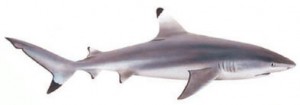
| Length |
Up to 6 ft, generally under 5 ft |
| Description |
Light brown with large black marks on the first dorsal fin and lower tail tips; no interdorsal ridge |
| Food |
Eats small reef fishes and invertebrates |
| Habitat |
Can be seen very close to the coastline and coral reef edge; found from the surface to 100 ft |
Gray reef shark
Carcharhinus amblyrhynchos
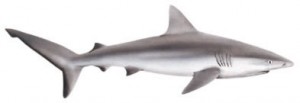
| Length |
Up to 8 ft, generally under 6 ft (maximum reported in Hawaii, 6.2 ft) |
| Description |
Gray with a slight white streak on the back edge of the dorsal fin and an easy-to-see black margin on the trailing edge of the tail; no interdorsal ridge |
| Food |
Eats bony fishes, cephalopods and crustaceans |
| Habitat |
Hawaiian records show caught from surface to 900 ft but most abundant at 320 ft; more common in the Northwestern Hawaiian Islands; tends to prefer reef areas with rugged terrain and strong currents |
Bignose shark
Carcharhinus altimus
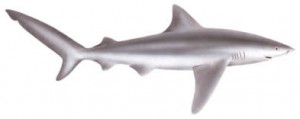
| Length |
Up to 9.5 ft, average 6 ft |
| Description |
Gray, large shark with prominent nasal flaps and high interdorsal ridge |
| Food |
Eats deepwater fishes (including sharks and rays), cephalopods |
| Habitat |
From about 90 to 1,200 ft |
Blacktip shark
Carcharhinus limbatus

| Length |
Up to 8 ft |
| Description |
Gray with black edges on dorsal and pectoral fins; a pointed snout. |
| Food |
Eats octopus, squid, bony fishes, occasionally crustaceans |
| Habitat |
In Hawaii, caught at depths of 40-210 ft; pups seen from Kaneohe Bay to Midway Atoll |
Sandbar shark
Carcharhinus plumbeus
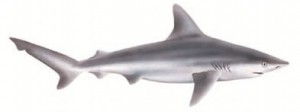
| Length |
Up to 8 ft, generally under 6 ft |
| Description |
Gray or light tan; high dorsal fin, strong interdorsal ridge; and no distinct marking |
| Food |
Eats small reef fishes, octopus and squid, crustaceans, mollusks |
| Habitat |
From about 30-900 ft; females cruise in shallower areas – average 223 ft |
Tiger shark (Hawaiian: niuhi)
Galeocerdo cuvier
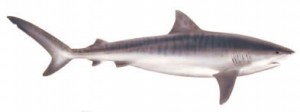
| Length |
Up to 18 ft, generally under 14 ft |
| Description |
Broadly rounded snout; distinctive curved serrated teeth; strong spotting pattern in young sharks, turning to stripes which fade with age |
| Food |
Eats wide variety of marine animals, carrion – has been called “garbage can of the sea” |
| Habitat |
Alternate between coastal and pelagic environments, from the surface to about 2500 ft. While in coastal habitats, move vertically between surface and bottom to depths of about 300 ft. |
Scalloped hammerhead shark (Hawaiian: mano kihikihi)
Sphyrna lewini
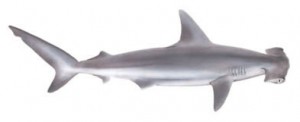
| Length |
Up to 14 ft, generally under 7 ft |
| Description |
Gray with flattened hammer-like head with a central indentation |
| Food |
Eats reef fishes, sharks and rays, cephalopods, crustaceans |
| Habitat |
Adults live off shore and come into shallower waters of Hilo Bay, Kaneohe Bay, Waimea Bay and other areas in Hawaii to pup – juveniles tracked in Kaneohe Bay stay near the bottom in deeper areas |
Smooth hammerhead shark (Hawaiian: mano kihikihi)
Sphyrna zygaena
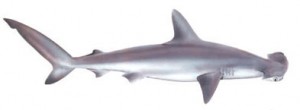
| Length |
Up to 13 f, generally under 8 ft |
| Description |
Gray with a flattened hammer-like head without median indentation |
| Food |
Eats bony fishes, small sharks and rays, cephalopods, crustaceans |
| Habitat |
In Hawaii, juveniles have been caught at depths of about 110-225 ft |
Whitetip reef shark (Hawaiian: mano lalakea)
Triaenodon obesus

| Length |
Up to 7 f, generally under 5 ft |
| Description |
Gray; slightly flat-headed with small white tips on the tops of the first and second dorsal and tail fins |
| Food |
Eats reef fishes, octopuses, crustaceans. |
| Habitat |
At depths of about 25-130 ft near coral reefs; seen resting in caves, sometimes for extended periods |
Odd Relatives
CHIMAERAS
Purple chimaera
Hydrolagus purpurescens
| Length |
Up to 3 ft or more |
| Description |
Purplish-gray dorsally, becoming darker ventrally; fins dark, with possible lighter spots on dorsal fin; dark lateral line including canals about head; fairly large green eyes |
| Food |
Presumed to feed on benthic invertebrates, perhaps fishes |
| Habitat |
Bottom areas in deep water, to depths of over 6,000 ft |
| Reproduction |
Ovipary; litter size possibly two; size at maturity uncertain |
Longnosed chimaera (Pacific spookfish)
Rhinochimaera pacifica
| Length |
Up to 4 ft |
| Description |
Pale brown dorsally, grayish-brown ventrally and around gill cover; white area around mouth and over snout; very long pointed snout; small eyes |
| Food |
Presumed to feed on benthic invertebrates |
| Habitat |
Bottom areas in deep water, to depths of over 4,000 ft |
| Reproduction |
Ovipary; litter size uncertain; size at maturity possibly 3.3 ftsnout; small eyes |
COASTAL RAYS
Diamond stingray
Dasyatis dipterura
| Length |
Disc width up to 3.2 ft or more |
| Description |
Brownish-black dorsally, white ventrally; dorsal and ventral folds on tail. |
| Food |
Eats crustaceans, mollusks, and bony fish |
| Habitat |
Sand and mud bottom areas to depths of 55 ft |
| Reproduction |
Aplacental vivipary, embryos feed on uterine milk after using up yolk sac; litter size and size at maturity uncertain |
Brown stingray
Dasyatis lata
| Length |
Disc width up to 5 ft |
| Description |
Olive- to blackish-brown dorsally, pale ventrally; distinctive snout; tail covered with tubercles |
| Food |
Eats crustaceans and bony fish |
| Habitat |
Sand and mud bottom areas from very shallow to depths of 700 ft or more |
| Reproduction |
Aplacental vivipary, embryos feed on uterine milk after using up yolk sac; litter size 3-4; size at maturity 3 ft disc width for males, 3.7 ft for females |
Spotted eagle ray
Aetobatus narinari
| Length |
Wingspan up to 6 ft or more (11.5 ft given in some references) |
| Description |
Black or bluish-black with white or light blue spots or rings dorsally, white ventrally; black pattern on underside of wings; pointed snout |
| Food |
Eats bivalves, crustaceans, worms, bony fishes |
| Habitat |
Generally inhabits bottom areas near land, from very shallow to depths of 230 ft or more, but often swims close to the surface |
| Reproduction |
Aplacental vivipary, embryos feed on uterine milk after using up yolk sac; litter size 1-4; size at maturity 4.6 ft wingspan for females (4-6 yrs), uncertain for males |
Manta ray
Manta birostris
| Length |
Wingspan up to 22 ft or more |
| Description |
Grayish-blue or greenish-brown to black dorsally, pale fin edges, white ventrally; pale patches on dorsal surface and dark blotches on ventral are unique to individuals and can be used for identification; rectangular terminal mouth with large cephalic lobes on each side |
| Food |
Eats planktonic crustaceans, small schooling bony fishes |
| Habitat |
Nearshore to pelagic waters, from near the surface to depths of 120 ft or more |
| Reproduction |
Aplacental vivipary, embryos feed on uterine milk after using up yolk sac; litter size 1-2; size at maturity may be 13 ft wingspan for males, 15 ft for females, although smaller size have been reported |
Spinetail devil ray
Mobula japanica
| Length |
Disc width up to 10 ft |
| Description |
Dark blue to black dorsally; white ventrally, often with dark patches; cephalic fins silvery-gray on inner surface with black tips; white markings behind eye; row of white denticles on each side of tail |
| Food |
Eats zooplankton |
| Habitat |
Nearshore to possibly pelagic surface waters, sometimes near sea floor, to depths of at least 60 ft |
| Reproduction |
Aplacental vivipary, embryos feed on uterine milk after using up yolk sac; litter size 1; size at maturity 6.5 ft disc width for females, uncertain for males |
DEEPWATER RAYS
Torpedo ray
Torpedo sp.
| Length |
Maximum disc width uncertain; specimens observed from submersible have not been positively identified to species level, and those captured by trawls have not been formally identified |
| Description |
Specimens photographed from submersible appear dark gray; broad body and short spineless tail |
| Food |
Diet uncertain; stuns prey with shock produced by electric organs located behind the eyes |
| Habitat |
Bottom areas in deep water, to depths of at least 1,500 ft |
| Reproduction |
Presumed aplacental vivipary with embryos feed on uterine milk after using up yolk sac; litter size and size at maturity uncertain |
Giant stingaree (Deepwater stingray)
Plesiobatis daviesi
| Length |
Disc width up to 5 ft |
| Description |
Grayish-brown to black dorsally, white with dark edges ventrally; long snout |
| Food |
Eats crustaceans, octopus, and some bony fishes |
| Habitat |
Bottom areas in deep water, to depths of at least 2,000 ft |
| Reproduction |
Presumed aplacental vivipary; uncertain if embryos receive uterine milk; litter size uncertain; size at maturity possibly 4.2 ft disc width for males, uncertain for females |
Sixgill stingray
Hexatrygon bickelli
| Length |
Disc width to at least 1 ft |
| Description |
Purplish-brown dorsally, white with dusky margins ventrally; underside of tail dark; long pointed snout, shape may be variable |
| Food |
Uncertain |
| Habitat |
Soft bottom areas in deep water, to depths of at least 3,200 ft |
| Reproduction |
Uncertain; litter size apparently 4; size at maturity uncertain |
PELAGIC RAYS
Pelagic stingray
Pteroplatytrygon violacea
| Length |
Disc width up to 2.6 ft |
| Description |
Dark brown to black dorsally and ventrally |
| Food |
Eats squid, crustaceans, bony fishes |
| Habitat |
Pelagic waters from near the surface by night to depths of 300 to 600 ft or more by day |
| Reproduction |
Aplacental vivipary, embryos feed on uterine milk after using up yolk sac; litter size possibly 4-7; size at maturity 1.1 ft disc width for males, 1.3 ft for females |
Offshore Sharks
White shark (Hawaiian: niuhi)
Carcharodon carcharias
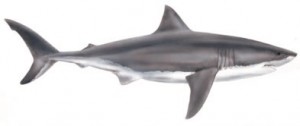
| Length |
Up to 21 ft or more |
| Description |
Gray with white underside; large; conical snout; large gill slits; sharp triangular teeth; strong keel and nearly symmetrical tail |
| Food |
Eats variety of bony fishes, sharks and rays, marine mammals, carrion, occasionally sea turtles and birds |
| Habitat |
Rare in Hawaiian waters |
Shortfin mako shark
Isurus oxyrinchus
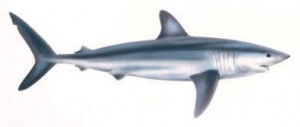
| Length |
Up to 14 ft |
| Description |
Short pectoral fins; very pointed conical snout with long dagger-like teeth; tail lobes nearly equal in size; pronounced keel at base of tail |
| Food |
Eats variety of fishes including tunas, mackerels, sharks |
| Habitat |
From depths of about 110-920 ft |
Silky shark
Carcharhinus falciformis

| Length |
Up to 10 ft, most are much smaller |
| Description |
Brownish-gray, large shark with small rounded dorsal fin, an interdorsal ridge and no distinctive markings |
| Food |
Eats bony fishes, including mackerels and tunas, cephalopods, pelagic crabs |
| Habitat |
In Hawaii, rarely appears in coastal waters |
Blue shark
Prionace glauca
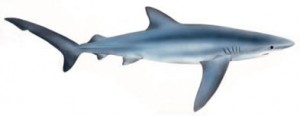
| Length |
Up to 12-13 ft, possibly up to 20 ft |
| Description |
Bluish gray, large slender shark with pointed snout, long pectoral fins, and anterior |
| Food |
Eats cephalopods, small bony fishes, crustaceans, mammalian carrion |
| Habitat |
Vertically migrates between the surface and 1,800 ft during the day and surface and 600 ft at night; near islands remains offshore during summer months, but appears to move closer to shore at twilight in the spring, returning to open ocean before sunrise |
Whale shark
Rhincodon typus
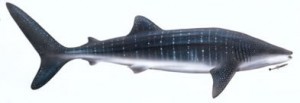
| Length |
Possibly up to 60 ft, usually 13-40 ft; world’s largest fish |
| Description |
A nearly terminal mouth, 300 rows of backcurved teeth (which are not used in feeding) and a unique checkerboard spot pattern on the body |
| Food |
Eats wide variety of plankton and nekton, including small fishes, crustaceans, squid |
| Habitat |
Often seen feeding at the surface; reported caught between 8,500 to 15,000 ft; in Hawaii, rarely found north of Kauai |
Thresher shark (Hawaiian: mano hi‘uka or mano laukahi‘u)
Alopias pelagicus
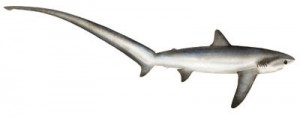
| Length |
Up to about 11 ft, generally under 10 ft |
| Description |
Very long tail, almost as long as rest of body; bluish-black dorsally becoming lighter on sides, off-white ventrally with white coloration not extending above pectoral insertions |
| Food |
Eats squid and bony fishes; stuns prey with tail before feeding |
| Habitat |
Pelagic waters from the surface to depths of over 500 ft |
Oceanic whitetip shark
Carcharhinus longimanus
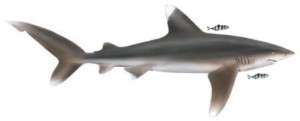
| Length |
Up to 13 ft, generally less than 10 ft |
| Description |
Gray; mottled tail and fin tips; enlarged first dorsal fin and long, paddle-shaped pectoral fins |
| Food |
Eats pelagic fishes, cephalopods, sea turtles, sea birds, marine mammal carrion |
| Habitat |
From the surface to 500 ft, most abundant in the tropics |
Megamouth shark
Megachasma pelagios
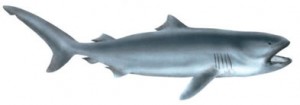
| Length |
Up to 18 ft |
| Description |
Blackish brown on back and sides, creamy underside; large head and huge distending mouth; large fleshy tail; white-tipped pectoral fins |
| Food |
Eats mostly pelagic crustaceans, some jellyfishes |
| Habitat |
Presumed vertically migratory from about 40 to 80 ft at night and 400 to 640 ft during the day; extremely rare; discovered off O‘ahu in 1976. |
Cookiecutter shark
Isistius brasiliensis

| Length |
Up to 20 in |
| Description |
Brownish black with a dark collar around the gill region and bright green eyes; sometimes referred to as the “cigar” shark; small dorsal fins are at the rear of its body |
| Food |
Eats squid, small fish, crustaceans; also bites off flesh from larger fishes, cetaceans and sharks |
| Habitat |
Caught at night, sometimes at surface or at depths up to 11,500 ft |
Other Sharks
COASTAL
Bluntnose six-gill shark
Hexanchus griseus
| Length |
Up to 16 ft, generally under 10 ft |
| Description |
Olive-green to brownish-gray, becoming paler ventrally, light colored lateral line; fins may have white edges; six long gill slits; broad rounded snout, small green eyes |
| Food |
Eats crustaceans, mollusks, fishes (including sharks), marine mammals |
| Habitat |
Coastal and deepwater, near the bottom and in the water column, from the surface to depths of over 6,000 ft |
| Reproduction |
Aplacental vivipary; litter size 22-108; size at maturity 9.5 ft for males, 13.5 ft for females |
DEEPWATER
False cat shark
Pseudotriakis microdon
| Length |
Length up to 10 ft |
| Description |
Dark brown to gray coloration; fin edges somewhat darker; long cat-like eyes; large spiracles; long anterior dorsal fin |
| Food |
Eats shrimp, octopus, fishes (including sharks) |
| Habitat |
Bottom-dweller at depths of about 600 to 5,000 ft |
| Reproduction |
Aplacental vivipary, embryos feed on eggs in uterus after using up yolk sac; litter size normally 2; size at maturity 6.5 ft for males, 7 ft for females |
Sponge-headed cat shark
Apristurus spongiceps
| Length |
Up to 1.6 ft or more |
| Description |
Dark brown body; thick body and head, grooves and pleats around gill slits and throat |
| Food |
Uncertain |
| Habitat |
Extremely rare; known for many years from only 2 specimens: one taken from Hawaii at 1,900 ft, the other from the Banda Sea at 4,800 ft |
| Reproduction |
Ovipary; only egg-laying shark in Hawaiian waters; litter size and size at maturity unknown. |
Prickly shark (Cooke’s shark)
Echinorhinus cookei
| Length |
Up to 13 ft |
| Description |
Grayish-brown body with black margins on fins; underside of snout light colored; no anal fin; large thorny denticles scattered about body and fins |
| Food |
Mollusks, fish (including sharks) |
| Habitat |
Bottom areas to depths of over 1,300 ft |
| Reproduction |
Uncertain, presumed aplacental vivipary; litter size to at least 114; size at maturity 6 ft for males, 6.5 ft for females |
Combtooth dogfish
Centroscyllium nigrum
| Length |
Up to 1.6 ft |
| Description |
Stippled black body; white tips on dorsal, pectoral, and pelvic fins; dorsal fin spines; no anal fin |
| Food |
Uncertain |
| Habitat |
Bottom areas to depths of over 3,700 ft |
| Reproduction |
Presumed aplacental vivipary; litter size uncertain; size at maturity 14 inches for males, females unknown |
Blurred smooth lantern shark
Etmopterus bigelowi
| Length |
Up to 2.2 ft |
| Description |
Black body; dorsal fin spines; no anal fin; luminescent ventrally |
| Food |
Eats squid and bony fishes |
| Habitat |
Bottom areas to depths of over 3,000 ft |
| Reproduction |
Presumed aplacental vivipary; litter size uncertain; size at maturity 1.4 ft for males, 1.6 ft for females |
Blackbelly lantern shark
Etmopterus lucifer
| Length |
Up to 1.6 ft |
| Description |
Dusky brown dorsally, becoming abruptly black ventrally; narrow black band around pelvic fins; no anal fin; luminescent ventrally |
| Food |
Squid, bony fishes, crustaceans |
| Habitat |
Vertical migrator, between depths of 600 to over 6,000 ft |
| Reproduction |
Aplacental vivipary; litter size to at least 8; size at maturity 7 inches for males, 8 inches for females |
Hawaiian lantern shark
Etmopterus villosus
| Length |
Up to 1.5 ft |
| Description |
Dark brown dorsally, darker ventrally; dark markings above pelvic fins; dorsal fin spines; no anal fin; luminescent ventrally |
| Food |
Uncertain |
| Habitat |
On or near bottom at depths of 1,200 to over 3,000 ft |
| Reproduction |
Aplacental vivipary; litter size and size at maturity uncertain |
Mosaic gulper shark
Centrophorus tessellatus
| Length |
Up to 3 ft |
| Description |
Light gray body, lighter bands at fin edges; green eyes; dorsal fin spines; no anal fin |
| Food |
Uncertain |
| Habitat |
Bottom areas to depths of over 2,300 ft |
| Reproduction |
Aplacental vivipary; litter size and size at maturity uncertain |
Gulper shark
Centrophorus granulosus
| Length |
Up to 5.5 ft |
| Description |
Light grayish brown dorsally, paler ventrally, greenish eyes, dorsal fins of adults have dusky tips |
| Food |
Eats bony fishes, squid, and crustaceans |
| Habitat |
Bottom areas to depths of 4,700 ft. |
| Reproduction |
Aplacental vivipary, litter size one or two, size at maturity average 3.6 ft. |
| Note |
Known from a single individual observed and photographed from a submersible |
Shortspine spurdog shark (Gray dogfish)
Squalus mitsukurii
| Length |
Up to 3.5 feet |
| Description |
Dusky gray body, lighter bands at fin edges; green eyes; dorsal fin spines; no anal fin |
| Food |
Eats crustaceans, mollusks, and bony fish |
| Habitat |
Bottom areas to depths of over 2,400 feet |
| Reproduction |
Aplacental vivipary; litter size 1-6; size at maturity 16 inches (14 years) for males, 25 inches (15 years) for females |
PELAGIC
Smalltooth sand tiger shark
Odontaspis ferox
| Length |
Up to 12 ft, generally 5 to 7 ft |
| Description |
Medium to dark gray dorsally, sometimes with scattered darker reddish spots on sides, lighter ventrally with blotches; pointed snout |
| Food |
Eats crustaceans, squid, fishes (including rays) |
| Habitat |
Pelagic waters and at deep bottom areas, from near the surface to depths of over 2,500 ft |
| Reproduction |
Aplacental vivipary, presumed uterine cannibal; litter size uncertain; size at maturity 9 ft for males, females uncertain |
Bigeye sand tiger shark
Odontaspis noronhai
| Length |
Up to 11 ft or more |
| Description |
Uniform dark chocolate brown; fins with dark margin on posterior edge; pointed snout |
| Food |
Uncertain, but known to eat bony fishes and squid |
| Habitat |
Pelagic and deep waters to depths of over 3,000 ft; habitat utilization not well understood |
| Reproduction |
Aplacental vivipary, presumed uterine cannibal; litter size uncertain; size at maturity about 11 ft for males and females |
Crocodile shark
Pseudocarcharias kamoharai
| Length |
Up to 3.6 ft; smallest lamnoid shark |
| Description |
Dark brown dorsally, sometimes with dark blotches on sides and ventral surface; pointed snout, long gill slits, very large eyes |
| Food |
Eats crustaceans, mollusks, bony fishes |
| Habitat |
Pelagic waters from the surface to about 1,900 ft; sometimes found near the bottom closer to shore |
| Reproduction |
Aplacental vivipary, embryos feed on eggs and possibly younger embryos in uterus after using up yolk sac; litter size generally 4; size at maturity 2.4 ft for males, 2.9 ft for females |
Bigeye thresher shark
Alopias superciliosus
| Length |
Up to 16 ft, generally under 13 ft |
| Description |
Very long tail, almost as long as rest of body; violet-gray dorsally becoming lighter on sides; distinctive v-shaped groove on top of head gives helmet-like appearance |
| Food |
Eats squid and bony fishes; stuns prey with tail before feeding |
| Habitat |
Pelagic waters and at deep bottom areas, from the surface to depths of over 1,600 ft |
| Reproduction |
Aplacental vivipary, embryos feed on eggs in uterus after using up yolk sac; litter size normally 2; size at maturity 9 ft (9-10 yrs) for males, 11 ft (12-13 yrs) for females |
Longfin mako
Isurus paucus
| Length |
Up to about 14 ft, generally around 7 ft |
| Description |
Dark blue to bluish-black dorsally, fading somewhat on the sides; conical snout |
| Food |
Uncertain, but thought to feed on squid and bony fishes |
| Habitat |
Pelagic waters from near the surface to depths of about 700 ft, but may go much deeper; may be vertical migrator between midwaters by day and surface waters at night |
| Reproduction |
Aplacental vivipary, embryos feed on eggs in uterus after using up yolk sac; litter size 2-8; size at maturity 7 ft for males, 8 ft for females |
Frilled shark
Chlamydoselachus anguineus
| Length |
Up to 6 ft or more |
| Description |
Brownish coloration with long narrow body, six frilled gill slits |
| Food |
Eats squid, fish |
| Habitat |
Pelagic surface waters to bottom areas at depths of over 4,000 ft |
| Reproduction |
Aplacental vivipary; litter size 2-12; size at maturity about 3 ft for males, 4.5 ft for females |
Kitefin shark
Dalatias licha
| Length |
Up to 5.3 ft |
| Description |
Black to brownish-gray body, may have darker spots; blunt snout with thick lips |
| Food |
Eats worms, mollusks, crustaceans, fish (including sharks and rays) |
| Habitat |
Pelagic waters from about 100 ft to bottom areas at depths of over 5,000 ft |
| Reproduction |
Aplacental vivipary; litter size 10-16; size at maturity 2.5 ft for males, 3.9 ft for females |
Smooth lantern shark
Etmopterus pussilus
| Length |
Up to 1.6 ft |
| Description |
Black body, yellow spot on head; broad dark mark around pelvic fins; dorsal fin spines; no anal fin; luminescent ventrally |
| Food |
Squid, fish (including small sharks) |
| Habitat |
Pelagic waters from near the surface to depths of over 3,000 ft |
| Reproduction |
Aplacental vivipary; litter size uncertain; size at maturity 1.2 ft for males and females |
Pygmy shark
Euprotomicrus bispinatus
| Length |
Up to 11 inches; smallest shark in Hawaiian waters |
| Description |
Charcoal gray to black body; clear fin edges; luminescent ventrally |
| Food |
Crustaceans, squid, bony fishes |
| Habitat |
Vertical migrator, from surface to depths of over 1,300 ft and possibly much deeper |
| Reproduction |
Aplacental vivipary; litter size to at least 8; size at maturity 7 inches for males, 9 inches for females |
Viper dogfish
Trigonognathus kabeyai
| Length |
Up to 1.3 ft |
| Description |
Dark brown to blackish body; dorsal fin spines; no anal fin |
| Food |
Crustaceans and bony fishes |
| Habitat |
Pelagic waters to depths of over 1,000 ft |
| Reproduction |
Presumed aplacental vivipary; litter size uncertain; size at maturity 14 inches for males, females uncertain |
Velvet dogfish
Scymnodon squamulosus
| Length |
Up to 2.8 ft |
| Description |
Black body; flat head, broad pectoral fins, dorsal fin spines; no anal fin |
| Food |
Uncertain |
| Habitat |
Deep pelagic waters to depths of over 6,000 ft |
| Reproduction |
Presumed aplacental vivipary; litter size uncertain; size at maturity 1.6 ft for males, 2.5 ft for females |




















